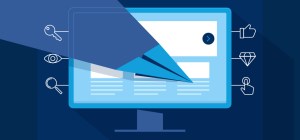There’s an art and a science to creating a solid landing page. You want it to look good, sure, but it also needs to drive a desired action.
This is where user experience comes into the fold.
User experience, often stylized as UX, centers around how a person interacts with your website or product. You want the experience to be helpful and accessible for all users, especially your target visitor. Peter Morville describes user experience design as a “big hive,” which he expands on with a seven-item honeycomb diagram that includes:
-
Useful
-
Usable
-
Desirable
-
Valuable
-
Findable
-
Accessible
-
Credible
He touches on the practical (“findable,” or easy-to-navigate design), the emotional (“desirable,” which ties into appreciating the value of images, branding, and the look of the site), and other components when considering the UX of a website.
Conversion rates vary among industries. Your user experience for your website can have an effect, positive or negative, on your sales. Thankfully, there are some standard to-dos that can help your efforts.
Combining UX and design best practices, you can enhance your landing pages. Whether you’re a designer, marketer, or other professional who creates them for your company’s website, there are a number of ways you can build on what you have and help increase sales.

The Basics of Good Landing Page Design
Before you can uplevel your landing page, you need to nail the basics of an effective one.
There are several (with a capital “S”) factors to take into account when crafting an optimal landing page. For this example, here are three of the top must-haves.
1. Strong Copy. This goes beyond great writing, although engaging copywriting on your website and sales material is a must. You want to talk to your reader — think “you” over “I” or “we” — and lean into benefits over features.
This is sometimes easier said than done, especially when you’re excited and want to tout your new product’s best qualities. You can do that, of course, but focus on how it serves your end user: Sell the sizzle, not the steak, as they say. When website visitors ask themselves, “What’s in it for me?” you want them to be able to easily answer so they comfortably move forward with the sale.
2. Excellent Graphics. Your product images need to be crisp and optimized for the web. The same goes for infographics and any other design you want to use on your landing pages.
Make sure you employ best practices as well. Add descriptive alt text and make sure any image copy is legible. Check the quality of your graphics on different technology, including tablets, mobile devices, and desktop screens, to ensure images display properly, too. That goes for the landing page overall; preview it to correct issues before hitting publish.
3. A Clear Call to Action (CTA). A good CTA should be concise and direct. Whether your goal is to get someone to subscribe, secure a lead, or make a sale, you want to eliminate any extra noise that distracts from that objective. This means choosing the right language, complimentary colors, and clear placements for your CTAs among your images and copy.
Depending on whether you’re marketing to a B2B or B2C audience, your messaging will differ a bit. The fundamentals remain the same.
Once you have your foundational pieces in place for a strong landing page, you can build on them. With conscientious tweaks, you can drive even more conversions.

6 Ways to Improve Your Landing Pages — and How
There are several ways you can upgrade your landing pages to enhance them for your business and your audience. Whether it’s a feature or best practice, these suggestions will help you secure more on-brand leads.
Each feature or task has an explanation as to why it helps improve the user experience with a landing page, along with further information or instructions. In no particular order, here are some essentials to address.
1. Improve your search engine optimization (SEO).
When you hear “SEO,” you might default to your blog content. However, you should strive for your entire site, landing pages and all, to rank well and be findable online.
Make sure the content on your landing page is keyword rich and targets your ideal user. Conduct keyword research and use phrases in your copy — and header tags and meta description, too — that match the intent of the person you’re trying to reach. Update this copy regularly to provide value and travel up the search engine results pages. With targeted keywords and copy, you’ll increase your chances of turning visitors into customers.
2. Increase your site speed.
A slow-to-load site can crush both your user experience and bottom line. Google reports that “more than half of visits are abandoned if a mobile page takes over three seconds to load.”
Time is money, literally.
Cleaning up “heavy” images by resizing and converting them to JPEGs, for instance, can help your site and landing page load faster. If your site is especially slow, consider a content delivery network (CDN). Many big-name sites use them to help boost the transfer of internet content, such as HTML pages and videos.
3. Keep it simple.
Related, eliminate clutter and unnecessary page elements from your landing pages. While you don’t want people to bounce immediately, you also don’t want them to land and get confused about what their next move should be, either.
Remove extraneous images, off-topic copy, and other extras. Once a visitor lands on your page, make the next move simple and obvious: Don’t make them click around, or take your desired action just to bounce because you put too many additional requests on them. Depending on your ask, requesting their full name and email address may be all you need at this stage. Don’t overcomplicate your landing pages.

4. Personalize your marketing.
Specialized communications are important to many users. And this type of personalized experience is increasingly becoming the norm for — and an expectation from — consumers.
Implement one-to-one (1:1) engagements across all touchpoints with your users, including on your landing pages. You can create different landing pages per traffic type (more on that next). When you have a good idea of who your ideal customer is, and you collect data on them from their shopping behaviour to past-purchase history, you can use this data to better customize their customer journey, down to the landing pages they see. An engaged user is a happy user, after all.
5. Use multiple marketing channels.
This goes for on and off your landing page. Search, email marketing, social media — there are numerous ways to reach potential customers and change up your messaging depending on the platform.
Refer to your existing customer data when creating campaigns, but don’t be afraid to experiment with different verticals, too. Add links to your social profiles, blog, and homepage on your landing pages to keep people engaging with your brand. The latter is helpful when a user isn’t ready to make a purchase, but they still want to learn more about what you have to offer them, and perhaps use this information for future buying decisions.
6. Access tools and software.
By testing your landing pages you can use data to fuel impactful changes. As opposed to going off gut feelings or what people might tell you they would choose, you have evidence of what they actually did select. This can help you inform important design and user-centric choices.
In addition to monitoring a visitor’s interactions with your page and collecting valuable user data, you can use tools like templates to assist with landing page design.
Enhancing Your Landing Pages, One User-Focused Step at a Time
Once you perfect your landing page user experience, conversions should trend positively. If something’s amiss, you can always test, make changes, and record your results to improve the experience.
Use these data points and good design best practices to keep people sticking around your brand, online and off.
























